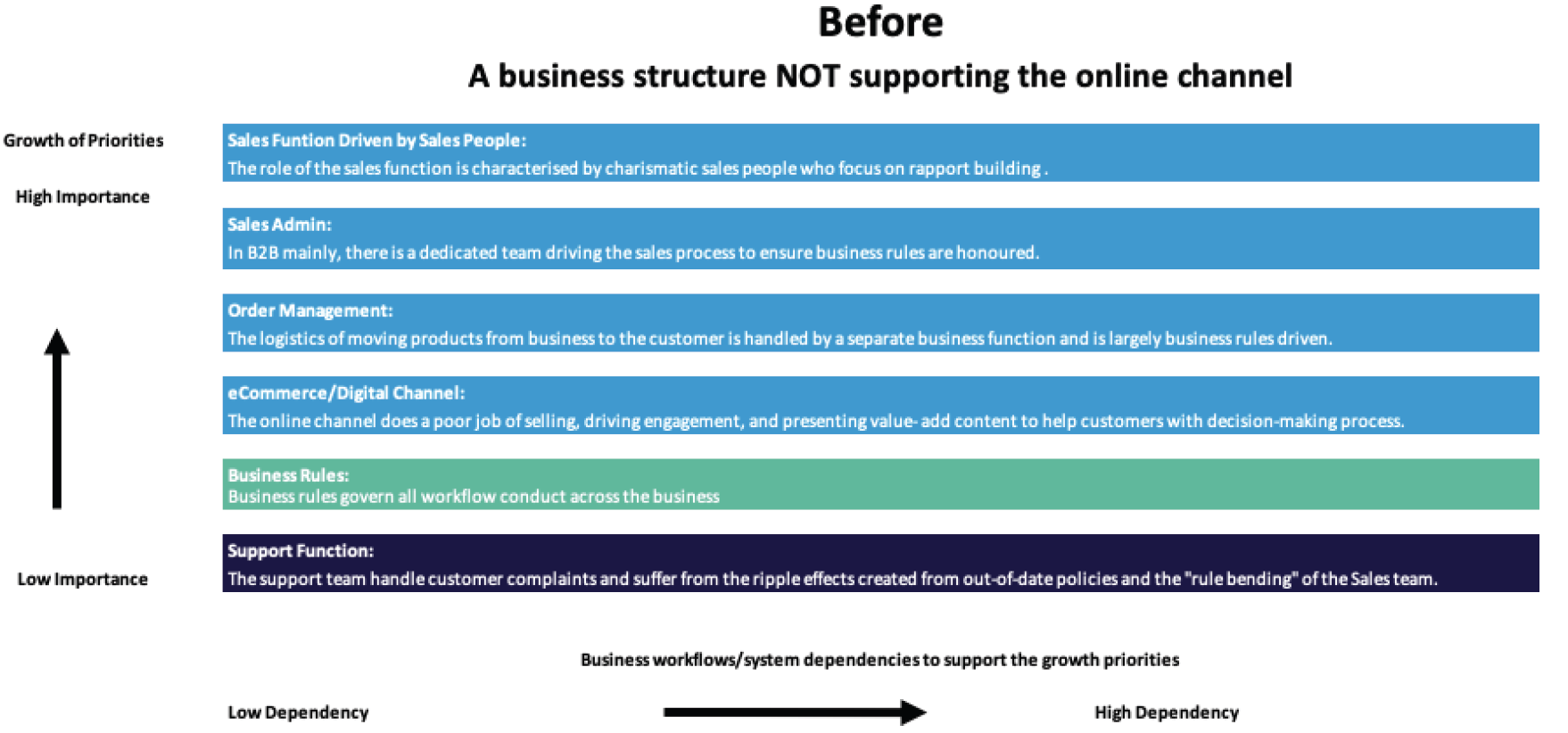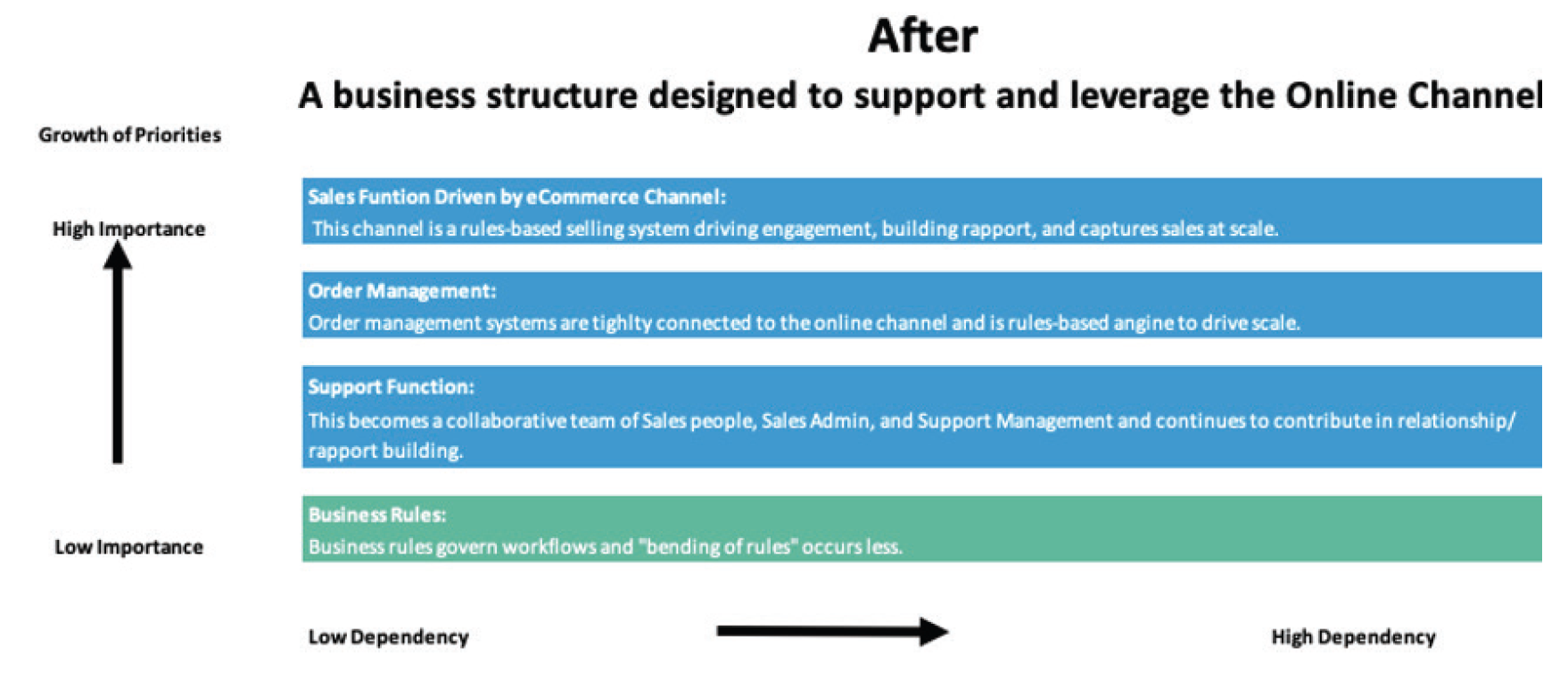Digital strategist Greg Randall defines the business evolution to leverage the online channel.
For retailers and B2Bs to leverage the power of the online channel, evolving the eCommerce technology is one piece of a bigger puzzle.
It’s not just a channel evolution, it’s a business-wide evolution.
To illustrate what a business-wide evolution needs to look like to support the online channel, two diagrams have been created: the Before and After.
The Before diagram shows what businesses commonly look like where the online channel is underperforming.
"If the business places the new technology into a Before business structure, it will never capitalise on its potential."
The After diagram and commentary is what a business needs to look like to fully leverage the online channel and drive scalable business wide growth.
Knowing the distinction between the Before and After is important because retailers and B2Bs can – and do – invest heavily in a new eCommerce platform, but if the business places the new technology into a Before business structure, it will never capitalise on its potential.
The two illustrations have an X- and Y-Axis
Vertical Y-Axis – Growth Priorities
The vertical axis represents how a business ranks the importance of a business function to drive growth.
Horizontal X-Axis – Business Dependency
The horizontal axis represents the level of dependency the business has on workflows and systems to support each function.
The Before
A business structure not supporting the online channel.

Sales Function Driven by Sales People
The role of the sales function is characterised by charismatic sales people who focus on rapport building and have the role of:
- Driving engagement and are strong ‘closers’ but poor at process
- Have strong product knowledge and/ or have access to product collateral
- Drives sales from new customers and repeat sales from existing customers
Sales Admin
In B2B mainly, there is a dedicated team driving the sales process to ensure business rules are honoured.
Order Management
The logistics of moving products from the business to the customer is handled by a separate business function and is largely business rules driven.
There is tension between sales and order management departments due to the ‘over promising’.
Software systems supporting this function are inflexible, and difficult to change and evolve.
eCommerce/Digital Channel
The online channel does a poor job of selling, driving engagement, and presenting value-add content to help customers with decision-making processes.
The online channel is siloed from all other departments and has no individual who is fully accountable for its performance and conduct.
This channel is part of existing business departments (sales/marketing).
Business Rules
Business rules govern all workflow conduct across the business.
‘Bending’ commonly comes as a result of legacy systems. Instead of replacing the system, the business forces customers to comply to outdated policies.
Support Function
The support team handle customer complaints and suffer from the ripple effects created from out-of-date polices and the ‘rule bending’ of the sales team.
Because the support function is siloed from sales, there is no accountability for actions which increases tension and frustration.
The After
A business structure designed to support and leverage the online channel. Both the X- and Y-axis remain unchanged.

Sales Function Driven by eCommerce Channel
- This channel is a rules-based selling system driving engagement, building rapport, and captures sales at scale
- The online channel simplifies access to product content, pricing, inventory availability, and where product can be found in physical store locations
- The performance of this channel is owned by a member of the executive team who actively collaborates with other department heads to drive business-wide harmony
Order Management
Order management systems are tightly connected to the online channel and is a rules-based engine to drive scale. The order management function has a high standard of transparency across the entire workflow so the business can see every stage of a product’s progress to reach its destination (in the customer’s hands).
The order management system has flexibility to enable the business to adapt its methods of picking, packing and delivering products to customers.
Support Function
This becomes a collaborative team of sales people, sales admin, and support management and continues to contribute in relationship and rapport building.
This is how business rules are modified and is why the eCommerce leader must have a chair at the executive level.
Though customer-led data comes from the bottom-up, the activation of change comes from the top-down.
Business Rules
Because business rules are now tightly linked to the eCommerce channel, instead of the business bending rules, it addresses the issues where rules need to be bent to create happy customers.
If a ‘bent rule’ is found to be due to a policy not being aligned to customer need, the policy evolves and changes. The eCommerce channel is then modified to support this policy evolution.


